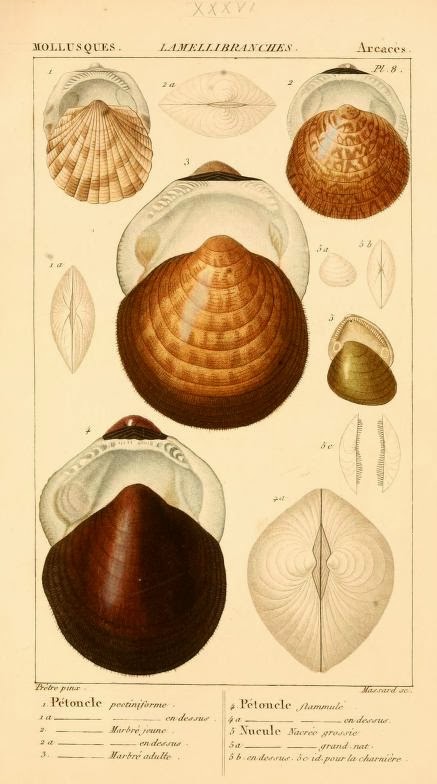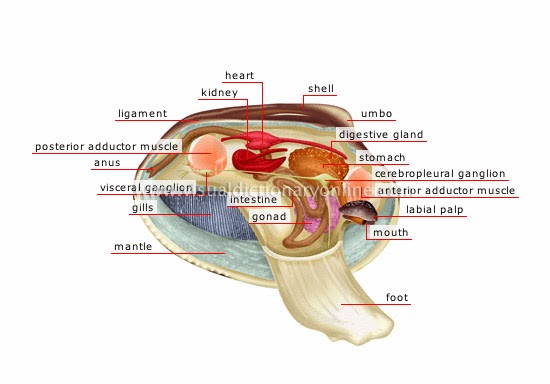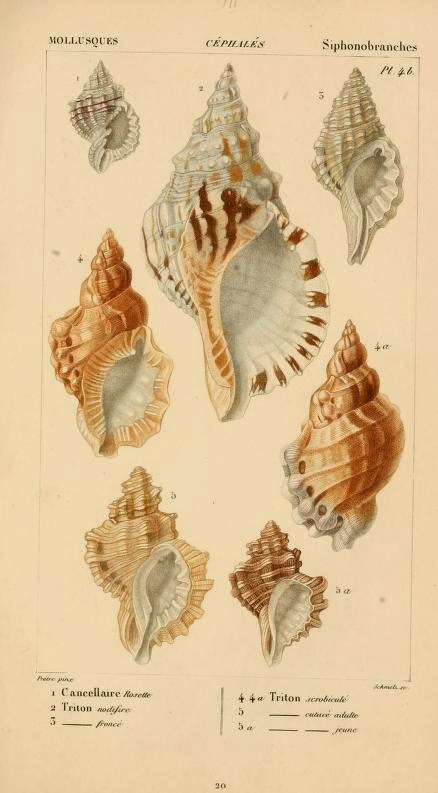Book of the Week: Malacozoaires, ou, Animaux mollusques
 |
|
There are approximately 100,000 species
of molluscs.
|
Have you ever collected seashells from the sea shore? Ever wonder where they come from or the former inhabitants? Well, they come from Molluscs. Molluscs are invertebrates that include squid, octopuses, cuttlefish, nudibranchs, snails, slugs, limpets, sea hares, mussels, clams, oysters, scallops, and other lesser known creatures.
Molluscs, belong to the phylum Mollusca, a major division of invertebrates with over 100,000 species, second to Arthropods. Their ability to survive is inspiring. They can be found at all latitudes and in both tropical and temperate regions. There are generally 10 recognized classes of molluscs: Aplacophora, Bivalvia, Cephalopoda, Polyplacophora, Gastropoda, Monoplacophora, Pleistomollusca, Polyplacophora, Rostroconchia, Scaphopoda, and Helcionelloida. Rostroconchia and Helcionelloida are both extinct.
Aplacophora and Monoplacophora are only found in the deep sea. The most diverse class is the Gastropods, which include slugs, sea butterflies, conchs, oyster borers, coweries, and snails. Gastropods account for more than a third of all living molluscs and there are between 60,000 and 80,000 living species. Class Cephalopoda including squid, cuttlefish, and octopuses are among the neurologically most advanced of all invertebrates. All Molluscs produce eggs.
 |
| Anatomy of a Bivalve Shell Image: Merriam-Webster’s Visual Dictionary Online |
Molluscs are distinguished by their anatomy, which generally consist of a head-foot and visceral mass. They secrete a hard shell that covers and protects the visceral mass (area that contains the internal organs) and mantle, a layer of epidermal soft tissue that covers the visceral mass. This calcium shell protects them from harsh environments and predators. The nervous system of the Mollusc is similar with two nerve cords. The exception is Bivalvia, which has three. In addition, their body structures range in a variety of ways. It is difficult to apply one characteristic to all classes of Molluscs. Aplacophorans are the only species that do not have a well-developed foot.
 |
|
Some molluscs don’t have a head.
|
As mentioned earlier, the shell is created by the protein conchiolin secreted from the mantle. The shell consists of three layers: periostracum (outer layer) of organic matter, mainly conchiolin; a middle layer of columnar calcite; and an inner layer of laminated calcite, often times nacreous also known as mother of pearl. The first two layers also contain chitin, a derivative of glucose found in the natural world.
Published between 1829-1830, Malacozoaires, ou, Animaux mollusques (English translation: Malacozoaires, or Shell Fish Animals) was written by French zoologist and anatomist Henri Marie Ducrotay de Blainville, curator and professor of invertebrate zoology at the Muséum national d’Histoire naturelle and a member of the French Academy of Sciences. De Blainville like many scientists, longed to give order to the natural world. Malacozoaires, ou, Animaux mollusques is the result of this desire. This monograph provides several orders and genera for species studied in France. While there is significantly more information about mollusks today, his book was a start to understanding the unknown.
If French comes natural to you and vous parlez ou lisez francais, read Malacozoaires, ou, Animaux mollusques.
Check out the beautiful shells from the book at the BHL Flickr here.
References:
EOL Rapid Response Team (n.d.). Mollusca (Mollusks).Encylopedia of Life. Retrieved from http://eol.org/pages/2195/details
Hayward, PJ (1996). Handbook of the Marine Fauna of North-West Europe“>. Oxford University Press. p. 484–628.
Porter, S. (2007). “Seawater Chemistry and Early Carbonate Biomineralization”. Science 316 (5829): 1302.
Unknown (n.d.). Henri Marie Ducrotay de Blainville. Wikipedia. Retrieved from http://en.wikipedia.org/wiki/Henri_Marie_Ducrotay_de_Blainville
Unknown (n.d.). Mollusca. Wikipedia. Retrieved from http://en.wikipedia.org/wiki/Mollusca





Leave a Comment